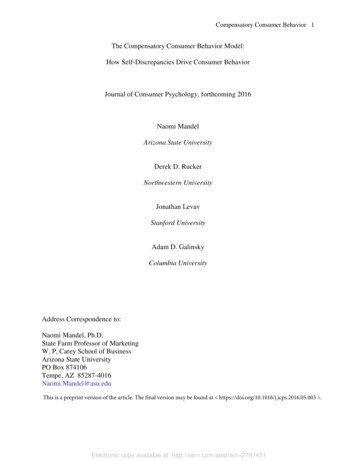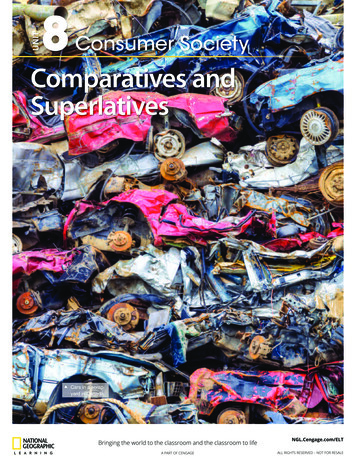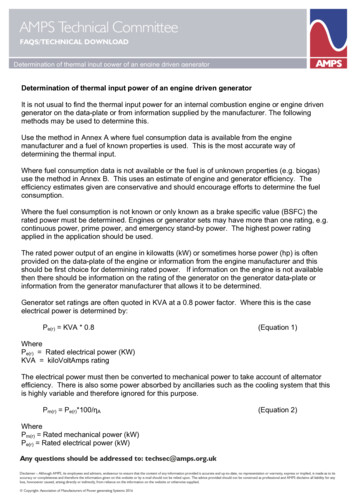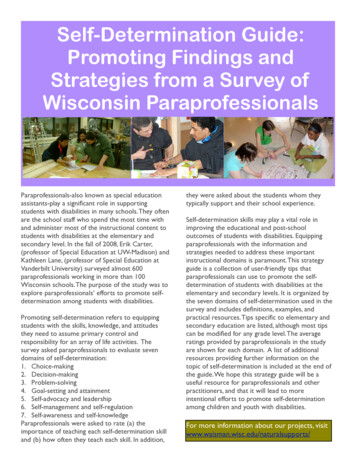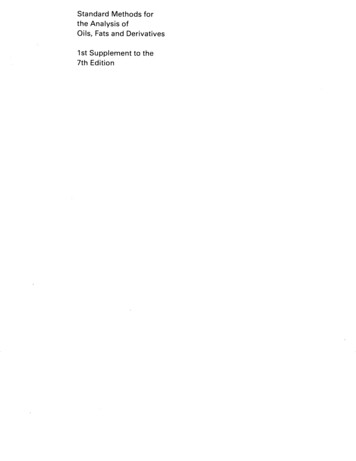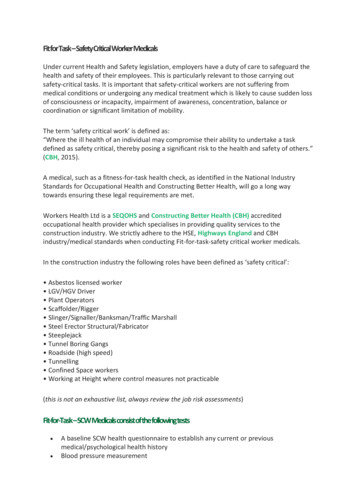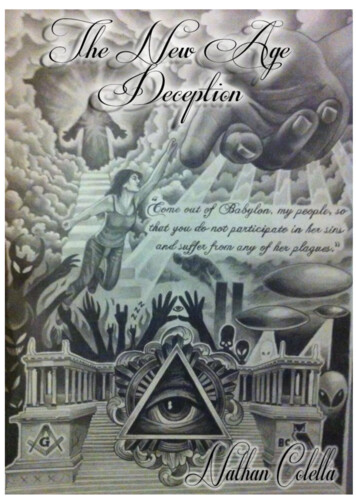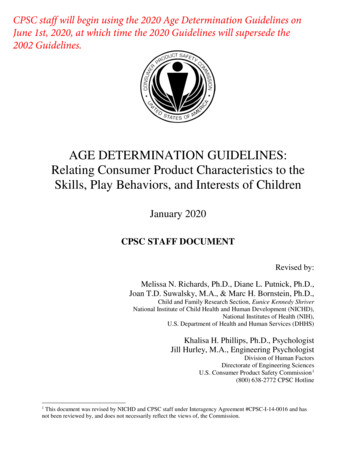
Transcription
CPSC staff will begin using the 2020 Age Determination Guidelines onJune 1st, 2020, at which time the 2020 Guidelines will supersede the2002 Guidelines.AGE DETERMINATION GUIDELINES:Relating Consumer Product Characteristics to theSkills, Play Behaviors, and Interests of ChildrenJanuary 2020CPSC STAFF DOCUMENTRevised by:Melissa N. Richards, Ph.D., Diane L. Putnick, Ph.D.,Joan T.D. Suwalsky, M.A., & Marc H. Bornstein, Ph.D.,Child and Family Research Section, Eunice Kennedy ShriverNational Institute of Child Health and Human Development (NICHD),National Institutes of Health (NIH),U.S. Department of Health and Human Services (DHHS)Khalisa H. Phillips, Ph.D., PsychologistJill Hurley, M.A., Engineering PsychologistDivision of Human FactorsDirectorate of Engineering SciencesU.S. Consumer Product Safety Commission 1(800) 638-2772 CPSC Hotline1This document was revised by NICHD and CPSC staff under Interagency Agreement #CPSC-I-14-0016 and hasnot been reviewed by, and does not necessarily reflect the views of, the Commission.
(This page intentionally left blank)
CONTENTSPagePRODUCT SUBCATEGORY INDEX . IIIINTRODUCTION . 1BACKGROUND . 3Small Parts Regulation . 3Use and Abuse Testing. 4Age Labeling and Determinations . 5Consumer Product Safety Improvement Act . 6ASTM F963 Toy Safety Standard. 7Children’s Toy . 9Child Care Article . 9Children’s Products . 9A USER GUIDE TO THE AGE DETERMINATION GUIDELINES . 11History of the Age Determination Guidelines . 11Organization of the Age Determination Guidelines. 12CHILDREN’S BASIC ABILITIES AND PREFERENCES . 19EXPLORATORY AND PRACTICE PLAY . 29Mirrors, Mobiles, & Manipulatives . 31Push & Pull Toys . 45BUILDING PLAY . 55Blocks . 57Interlocking Building Materials . 71PRETEND & ROLE PLAY. 81Dolls & Stuffed Toys . 83Play Scenes & Puppets . 99Dress-Up Materials . 109Small Vehicle Toys . 121Tools & Props . 135GAME & ACTIVITY PLAY . 147Puzzles. 149Card, Floor, Board, & Table Games . 159i
SPORTS, RECREATIONAL, & OUTDOOR PLAY . 169Ride-On Toys . 171Recreational Equipment . 181Sports Equipment . 197MEDIA PLAY . 207Arts & Crafts . 209Musical Instruments . 223EDUCATIONAL & ACADEMIC PLAY . 237Books . 239Learning Products . 253TECHNOLOGY PLAY . 263Smart Toys & Educational Software. 265Audiovisual Equipment. 277Computer & Video Games . 293REFERENCES . 307PRODUCT INDEX . 323ii
PRODUCT SUBCATEGORY INDEXPageArts & Crafts . 209Audiovisual Equipment . 277Blocks . 57Books . 239Card, Floor, Board, & Table Games . 159Computer & Video Games. 293Dolls & Stuffed Toys . 83Dress-Up Materials . 109Interlocking Building Materials . 71Learning Products . 15Mirrors, Mobiles, & Manipulatives . 31Musical Instruments . 223Play Scenes & Puppets. 99Push & Pull Toys . 45Puzzles . 149Recreational Equipment . 181Ride-On Toys . 171Small Vehicle Toys . 121Smart Toys & Educational Software . 265Sports Equipment . 197Tools & Props . 135iii
(This page intentionally left blank)iv
INTRODUCTIONThe 2020 U.S. Consumer Product Safety Commission Staff (CPSC staff) document titled, AgeDetermination Guidelines: Relating Consumer Product Characteristics to the Skills, PlayBehaviors, and Interests of Children, supersedes the (2002) Age Determination Guidelines:Relating Children’s Ages to Toy Characteristics and Play Behavior.This document presents age-grading information in the form of guidelines for toys and otherarticles, children’s toys, child care articles, and children’s products. CPSC staff performs agedeterminations, in which the various characteristics of a consumer product are matched to theskills, play behaviors, and interests of children in a particular age group. For manufacturers, agegrading is an important step in developing, marketing, and labeling consumer products. Usinginformation from the Age Determination Guidelines to determine whether a general use productwould be appropriate for children is an important consideration for them as well. Oncemanufacturers determine a target age for a product through age grading, CPSC staff encouragesmanufacturers to label, promote, and market it to that age group. Accurate age labels provideparents and other consumers with guidance for selecting age-appropriate products for children.CPSC’s regulations have long required that consumer products be constructed to withstand thereasonably foreseeable uses and abuses of children within specified age groups. The ConsumerProduct Safety Improvement Act of 2008 (CPSIA) imposed new obligations, such as requiringmanufacturers of children’s products to certify, based on third-party testing, that their productsmeet CPSC standards. The results of age determinations directly impact the type and severity ofmechanical and chemical tests the samples may subsequently undergo to identify potentialhazards.Additions and updates to the age groups for products found in the revised Age DeterminationGuidelines are based on (1) observational research of children’s play with products by Child andFamily Research at NICHD/NIH under Interagency Agreement CPSC-I-14-0016, (2) publiccomments received by the CPSC, and (3) age grading by CPSC Human Factors staff. Staff hasupdated/expanded the Introduction, titling the new chapters, Background, and A User Guide tothe Age Determination Guidelines. The Background chapter provides an overview of the relevant1
Introductionstatutes, regulations, and standards that are frequently consulted for age grading. The User Guidechapter provides a brief history of the Age Determination Guidelines, as well as information onhow the material is organized.The guidance found in the following Background chapter is provided for convenience and maynot necessarily reflect the latest version of the regulations in the CFR or other applicable statutes.Check the applicable statutes and regulations to determine the current requirements for anapplicable law. For further guidance, you can also visit CPSC’s Business Education website ss-Education.The Age Determination Guidelines explain how CPSC staff develops its assessment of ages forconsumer products. The Age Determination Guidelines are not a mandatory rule, and CPSC willnot enforce them as such. Rather, they present CPSC staff’s views on age grading.Manufacturers and others may use the Age Determination Guidelines to help them determine theappropriate age group for their product(s).2
BACKGROUNDEstablished in 1972 by the Consumer Product Safety Act (CPSA), 2 the CPSC is charged withprotecting consumers from unreasonable risks of injury associated with consumer products. Toaccomplish this goal, CPSC develops standards, pursues recalls, and in certain circumstances,issues bans on products that are intended for children of certain ages. Additionally, CPSCenforces numerous regulations under other statutes, some of which apply to products for childrenwithin specific age groups. For example, CPSC administers the Federal Hazardous SubstancesAct (FHSA), 3 under which it has issued certain regulations regarding toys and other articles. TheChild Safety Protection Act (CSPA) of 1994 amended sections of the FHSA to require labelingof certain products that pose a choking hazard to children within a specified age range (e.g.,small balls, balloons, marbles). The Labeling of Hazardous Art Materials Act (LHAMA), 45amended the FHSA to require labeling of all art materials determined to have a potential chronichazard for health. One regulation issued under the FHSA with very specific age-specificrequirements is the Small Parts Regulation.Small Parts Regulation 6In 1979, the Commission issued a regulation under provisions of the FHSA to ban certain toysand other articles that are intended for use by children under 3 years of age, if they present achoking, aspiration, or ingestion hazard because of small parts. This regulation, known as theSmall Parts Regulation, is found in 16 CFR §§ 1500.18(a)(9), 1500.50–.52, and part 1501.Introduction or delivery for introduction into interstate commerce of a banned item is aprohibited act under section 4 of the FHSA and subjects the firm to the penalties described insection 5 of the FHSA. The regulation does not apply to toys or other articles that are solelyintended for use by children 3 years of age and older, or to toys and other articles that children2Consumer Product Safety Act (CPSA) of 1972. PL 92-573. Available at https://www.cpsc.gov/s3fspublic/pdfs/blk media cpsa.pdf?epslanguage en3Federal Hazardous Substances Act (FHSA) of 1960. PL 86-613. Available at https://www.cpsc.gov/s3fspublic/pdfs/blk pdf fhsa.pdf4Labeling of Hazardous Art Materials Act (LHAMA) of 1988. PL 100-695. Available at:https://www.cpsc.gov/s3fs-public/pdfs/blk pdf fhsa.pdf5LHAMA amended the FHSA and adopted ASTM D-4236 as a regulation6This abbreviated description of the Small Parts Regulation does not replace or supersede any requirementspublished in 16 CFR §§1500.18(a)(9), 1500.50–53, and part 1501.3
Backgroundunder 3 years of age might have access to simply because of the products’ presence in thehousehold. For a detailed list of toys and other articles covered by, and exempted from, thisregulation, see 16 CFR part 1501. The Small Parts Regulation specifies the equipment and testmethod used to determine whether a toy or other article presents a choking, aspiration, oringestion hazard because the product itself, or any part of the product that could be detached orbroken off during normal or reasonably foreseeable use and abuse, is a small part. (See 16 CFR§1501.4 for further details.) If the toy or other article being tested fits entirely within the cylinderused for testing, it is considered a small part. If it does not, it is subjected to use and abuse testprocedures.Use and Abuse TestingCPSC established test procedures to simulate normal or reasonably foreseeable use, damage, orabuse to which toys and other articles intended for use by children may be subjected. These testprocedures are found in 16 CFR §§1500.50–53; The regulation at 16 CFR §1500.51 specifies testprocedures and forces that simulate use and abuse of toys and other articles intended for use bychildren 18 months or younger; 16 CFR §1500.52 specifies test procedures and forces thatsimulate use and abuse of toys and other articles intended for use by children over 18 monthsold, but not over 36 months of age. Any toy or other article intended for children under 3 yearsof age that has undergone use and abuse testing with resulting detached or liberated parts that fitentirely within the small parts test cylinder is banned. The regulation at 16 CFR §1500.53specifies test procedures and forces that simulate use and abuse of toys and other articlesintended for use by children over 36 months but not over 96 months of age.The five use and abuse tests specified in the Small Parts Regulation are impact, torque, tension,flexure, and compression. If these forces cause parts to break off that fit in the cylinder, thoseparts present a risk of choking, aspiration, or ingestion to children under 3 years of age. Table 1lists the criteria for each test, depending on the age of child for whom the toy or other article isintended. Except for the tension test, each test method shall be applied to a previously untestedsample. The tension test shall be applied to the same sample used in the torque test.4
BackgroundTable 1. Criteria in Small Parts Regulation TestsImpactFlexureTorqueTensionCompression10 dropsfrom4.5 ft 0.5 in120 Arc30 Cycles10 lb 0.5 lb2 lbf-in 0.2 lbf-in10 lb 0.5 lb20 lb 0.5 lbOver 18 but Not Over36 Months of Age(16 CFR § 1500.52)4 dropsfrom3 ft 0.5 in120 Arc30 Cycles15 lb 0.5 lb3 lbf-in 0.2 lbf-in15 lb 0.5 lb25 lb 0.5 lbOver 36 but Not Over96 Months of Age(16 CFR § 1500.53)4 dropsfrom3 ft 0.5 in120 Arc30 Cycles15 lb 0.5 lb4 lbf-in 0.2 lbf-in15 lb 0.5 lb30 lb 0.5 lb18 Months of Ageor Less(16 CFR § 1500.51)Age Labeling and DeterminationsAge labeling provides parents and other consumers guidance for selecting proper products forchildren. CPSC staff, therefore, encourages age labeling. However, age labeling must beaccurate. It is to the manufacturer’s or importer’s advantage to determine accurately the intendedage group for their products, and to label, promote, and market those products to that age group.If CPSC staff tests a toy or other article for small parts when the product is not clearly andconspicuously age-labeled, or is age-labeled inappropriately, CPSC staff performs the moststringent test from the two age groups for children under 3 years of age. For example, if a toy islabeled for children spanning more than one age group under 3 years (e.g., “12 to 24 mos.”),CPSC staff subjects it to the most stringent use and abuse tests for children 18 months or less,and over 18 but not over 36 months of age. If CPSC staff determines that the same toy isintended for children under 3 years of age, it is subjected to the Small Parts Regulation,regardless of its age labeling.For a firm to know whether the Small Parts Regulation applies to a particular toy or other article,the firm must determine the age of the child for whom the product is intended. For the SmallParts Regulation, the factors used to assist in determining which toys and other articles areintended for use by children under 3 years of age are found in 16 CFR § 1501.2(b) and involveevaluating: (1) the manufacturer’s stated intent, if reasonable, (2) the advertising, promotion andmarketing, and (3) common recognition. A table containing the exact wording of the abovecriteria appears later in the chapter.5
BackgroundRegarding small parts, CPSC staff performs age determinations in which the variouscharacteristics of a toy or other article are matched to the characteristics of children in aparticular age group to determine whether it is intended for children under 3 years of age. Forexample, children from 12 months through 18 months of age enjoy toys with bright colors,especially yellows and reds, and toys with high contrast and patterns. Therefore, toys withcharacteristics such as these may be considered appropriate for children of this age. As specifiedin the Small Parts Regulation, staff also considers how the toy or other article is labeled,marketed, advertised, and promoted. Although small parts that present a hazard are clearlyinappropriate for children under 3 years of age, the mere presence of small parts does notpreclude the possibility that CPSC staff would determine that product is intended for childrenunder the age of 3. Rather, when evaluating a product for age appropriateness, one ought toconsider whether parents and others would purchase the product for children under 3 years ofage, based on its characteristics and the characteristics of children of this age.Consumer Product Safety Improvement ActIn 2008, Congress passed the CPSIA, 7 giving the Commission new regulatory and enforcementtools for addressing mechanical and chemical safety hazards in consumer products that areintended for children. Most notable for age grading, the law (1) mandated the ASTM F963Standard Consumer Safety Specification for Toy Safety as a consumer product safety standard(incorporated by reference in 16 CFR part 1250), and (2) added a definition of “children’sproduct” in the CPSA. A children’s product is “a consumer product designed or intendedprimarily for children 12 years of age or younger.” 15 USC 2052(a)(2). The definition states fourfactors to consider. A manufacturer’s statement about intended use is one factor, but is notdeterminative. The Age Determination Guidelines are the fourth criterion to consider whendetermining what constitutes a “children’s product” under the CPSA.The CPSIA also added requirements that consumer products that are “children’s products” mustbe labeled with tracking labels and have valid Children’s Product Certificates (CPCs), based onpassing third-party test results from a CPSC-accepted laboratory. According to section 101 of7Consumer Product Safety Improvement Act (CPSIA) of 2008. Pub. L. No. 110-314. Available at:https://cpsc.gov/s3fs-public/pdfs/blk pdf cpsia.pdf6
BackgroundCPSIA, children’s products cannot contain more than 100 parts per million (ppm) of total leadcontent (substrate) or 90 ppm of lead in paint or other surface coatings. Additionally, productsmeeting the “children’s toy” or “child care article” definitions are subject to specified phthalatesprohibitions in CPSIA section 108 and 16 CFR part 1307. The regulation at 16 CFR part 1307made some changes to the list of prohibited phthalates in the CPSIA. Table 2 outlines therelevant statutory and regulatory definitions and evaluation criteria that are applicable to agegrading.ASTM F963 Toy Safety StandardASTM F963 8 Standard Consumer Safety Specification for Toy Safety is a comprehensive safetystandard covering performance requirements and test methods for addressing a wide range ofsafety hazards in toys that are intended for children under 14 years of age (includes 13-year-oldchildren). The status of ASTM F963 as a mandatory standard greatly expanded the scope andneed for age grading by CPSC staff, given the myriad age-specific requirements, wider agerange, and types of toys covered. The standard contains performance specifications to address awide range of mechanical safety hazards (e.g., projectiles, batteries, strings and cords, noise,magnets, and expanding materials), as well as chemical hazards (e.g., lead, cadmium, antimony,arsenic, barium, chromium, mercury, and selenium), in toys. Many of the performancerequirements in the standard have age limits, which were developed in response to known safetyhazards and/or the expected cognitive, physical development, and interests of children in acertain age group. CPSC staff often determines whether a toy meets the following definition inASTM F963 section 3.1.91: “toy - any object designed, manufactured, or marketed as aplaything for children under 14 years of age.” If the product is a toy under the standard, staff mayconduct a more extensive evaluation to determine the most appropriate age group. One referencethat staff consults is Annex A1: Age Grading Guidelines found at the back of ASTM F963. Theannex covers the purpose and objectives of age labeling, criteria to consult, sources ofinformation or “tools,” and how to factor in safety concerns when age grading. Furthermore, theannex references CPSC’s Age Determination Guidelines for age grading8ASTM Standard F963, Standard Consumer Safety Specification for Toy Safety (2017). ASTM International, WestConshohocken, PA, 2003, www.astm.org.7
DefinitionEvaluation Criteria (Variations in bold)Source(s)1) Toy or otherarticle for childrenunder 3 yearsNone“1) The manufacturer’s stated intent (such as on a label) if it is areasonable one;2) The advertising, promotion, and marketing of the article;3) Whether the article is commonly recognized as being intended for childrenunder 3.”16CFR §1501.2(b)2) Toy“Any object designed,manufactured, or marketedas a plaything for childrenunder 14 years of age.”NoneASTM F963-17 §3.1.913) Children’s toy“A consumer productdesigned or intended by themanufacturer for a child 12years of age or younger, foruse by the child when thechild plays.”“(i) A statement by a manufacturer about the intended use of such product,including a label on such product if such statement is reasonable.“(ii) Whether the product is represented in its packaging, display, promotion,or advertising as appropriate for use by children of the ages specified.(iii) Whether the product is commonly recognized by consumers as beingintended for use by a child of the ages specified.(iv) The Age Determination Guidelines issued by the Commission staff inSeptember 2002 and any successor to such guidelines.”CPSIA §108(b)(3)(e)(1)(B)4) Child carearticle“A consumer productdesigned or intended by themanufacturer to facilitatesleep or the feeding ofchildren age 3 and younger,or to help such children withsucking or teething.”Same as 3) Children’s toyCPSIA §108(b)(3)(e)(1)(C)5) Children’sproduct“A consumer productdesigned or intendedprimarily for children 12years of age or younger.”‘‘(A) A statement by a manufacturer about the intended use of suchproduct, including a label on such product if such statement isreasonable.(B) Whether the product is represented in its packaging, display, promotion,or advertising as appropriate for use by children 12 years of age or younger.(C) Whether the product is commonly recognized by consumers as beingintended for use by a child 12 years of age or younger.(D) The Age Determination Guidelines issued by the Commission staff inSeptember 2002, and any successor to such guidelines.”CPSA §3(a)(2)16 CFR §1200.2(b)8CategoryBackgroundTable 2. Definitions and Evaluation Criteria
BackgroundChildren’s ToyIn determining whether the prohibited phthalates requirements apply to a particular product,CPSC staff may evaluate whether the product meets the definition of a “children’s toy” underCPSIA section 108(b)(3)(e)(1)(B). The law at § 108(g)(1)(B) defines “children’s toy” as “aconsumer product designed or intended by the manufacturer for a child 12 years of age oryounger, for use by the child when the child plays.” Section 108(g)(2) of the CPSIA lists fourcriteria to determine whether a product meets the definition of “children’s toy.” Staff appliesthose criteria in the same manner as the similar four criteria for the definition of “children’sproduct” in section 3(a)(2) of the CPSA.Child Care ArticleIn determining whether the prohibited phthalates requirements apply to a particular product,CPSC staff may evaluate whether the product meets the definition of a “child care article” inCPSIA. The term “child care article” is defined in section 108(b)(3)(e)(1)(C) of the CPSIA as a“consumer product designed or intended by the manufacturer to facilitate sleep or the feeding ofchildren age 3 and younger, or to help such children with sucking or teething.” Staff uses thesame criteria to make determinations of children's toys in section 108 as it uses to identifyproducts as a “child care article.”Children’s ProductsCPSC staff often evaluates whether a consumer product meets the definition of a “children’sproduct” in section 3(a)(2) of the CPSA, as amended by the CPSIA in 15 USC 2052(a)(2). Thelaw defines a “children’s product” as “a consumer product designed or intended primarily forchildren 12 years of age or younger.” Similar to the criteria in the Small Parts Regulation forevaluating age appropriateness of toys and other articles for children under 3 years of age, thefirst three criteria in the CPSIA definition mention evaluating the manufacturer’s stated intent;marketing, advertising, and promotion; and common recognition. Differences between the SmallParts Regulation criteria and the definition
AGE DETERMINATION GUIDELINES: Relating Consumer Product Characteristics to the Skills,



